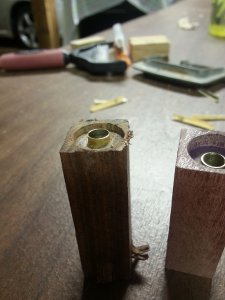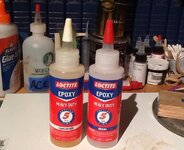cryptolo
Member
When I square up the ends of my blanks with the tubes inside this happens quite a lot. 
View in Gallery
For some reason I cannot get my holes drilled perfectly straight threw the blanks so when I put them in a small vice and back on the drill press with the tubes inside they are slightly catywompus which leads to friction from stress caused by the uneven hold and the tubes are pushed through the blanks. Is it my krukid holes as described above thats leading to my tubes being pushed out or is it my epoxy? I currently use this epoxy PSI Mid-Cure Epoxy at Penn State Industries
Thanks!
EDIT: I should note my epoxy is at least 4 years old... is that past its shelf life?

View in Gallery
For some reason I cannot get my holes drilled perfectly straight threw the blanks so when I put them in a small vice and back on the drill press with the tubes inside they are slightly catywompus which leads to friction from stress caused by the uneven hold and the tubes are pushed through the blanks. Is it my krukid holes as described above thats leading to my tubes being pushed out or is it my epoxy? I currently use this epoxy PSI Mid-Cure Epoxy at Penn State Industries
Thanks!
EDIT: I should note my epoxy is at least 4 years old... is that past its shelf life?
Last edited:

